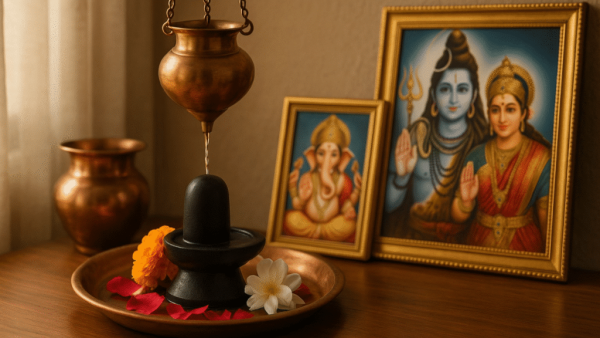
Mumbai: As the sacred month of Sawan unfolds, devotees across India immerse themselves in the worship of Lord Shiva, offering water (jalabhishek) and prayers to seek his blessings. While many visit temples, a significant number of devotees choose to bring the divine energy of Lord Shiva into their own homes by installing a Shivling — a symbolic representation of the divine. However, Vedic scriptures and the Shiv Puran outline certain important rules for doing so, which are often overlooked.
Lord Shiva is considered the easiest deity to please, yet he can also become displeased just as swiftly if rituals are not followed correctly. If you’re planning to perform jalabhishek at home or already have a Shivling in your puja room, understanding the guidelines mentioned in sacred texts becomes crucial. Here’s what you should know:
The Shivling at Home Must Not Be Larger Than Your Thumb
According to the Shiv Puran, a Shivling placed at home should never be bigger than a thumb. If it exceeds this size, it is treated as an idol that requires elaborate installation rituals (pran pratishtha). Without these, the presence of a larger Shivling may bring spiritual imbalance.
Always Face North While Performing Jalabhishek
When offering water to the Shivling, ensure your face is turned towards the north. Performing abhishek while facing south or east is considered inauspicious as per Hindu traditions.
The Shivling Must Never Be Left Dry
If you have installed a Shivling at home, it should never be left dry. Daily jalabhishek is necessary. Ideally, a jaladhari (a vessel with a continuous water drip) should be placed above the Shivling to maintain constant sacred hydration.
Choose the Right Type of Shivling
For household worship, Parad Shivling (made of mercury) or Narmadeshwar Shivling (found in the Narmada river) are recommended. These are considered spiritually suitable and auspicious for domestic altars.
Daily Puja is a Must
A Shivling kept at home must be worshipped every single day. This includes offering water, flowers, and prayers with utmost devotion. Skipping daily rituals may attract negative energies.
Avoid Plastic and Steel for Rituals
When performing jalabhishek, never use plastic or steel utensils. Sacred water should be offered using copper or brass vessels only, as these metals are spiritually purifying and traditional.
Include the Shiva Family in Your Altar
If you’re keeping a Shivling at home, it is important to also include idols or images of Goddess Parvati (Mata Gauri) and Lord Ganesha. A complete Shiva family is believed to bless the household with harmony and prosperity.
Never Offer Tulsi Leaves to Lord Shiva
While Tulsi is considered sacred in Hinduism, it should never be offered to Lord Shiva. Scriptures strictly prohibit this practice, considering it inauspicious.
Don’t Waste the Offered Water
After completing jalabhishek, do not throw away the water. Instead, pour it into a plant pot. Letting it drain away carelessly is discouraged, as the water is considered spiritually charged.
Bringing Lord Shiva’s energy into your home can be deeply transformative — but it must be done with reverence and awareness. Following these scripturally guided steps ensures that your home Shivling brings blessings, not unintended consequences. If you’re planning to start or continue this sacred practice during Sawan or beyond, let it be guided by devotion and discipline.
(Disclaimer: The information provided is based on traditional beliefs and religious texts. News9 Live does not endorse or validate these claims.)